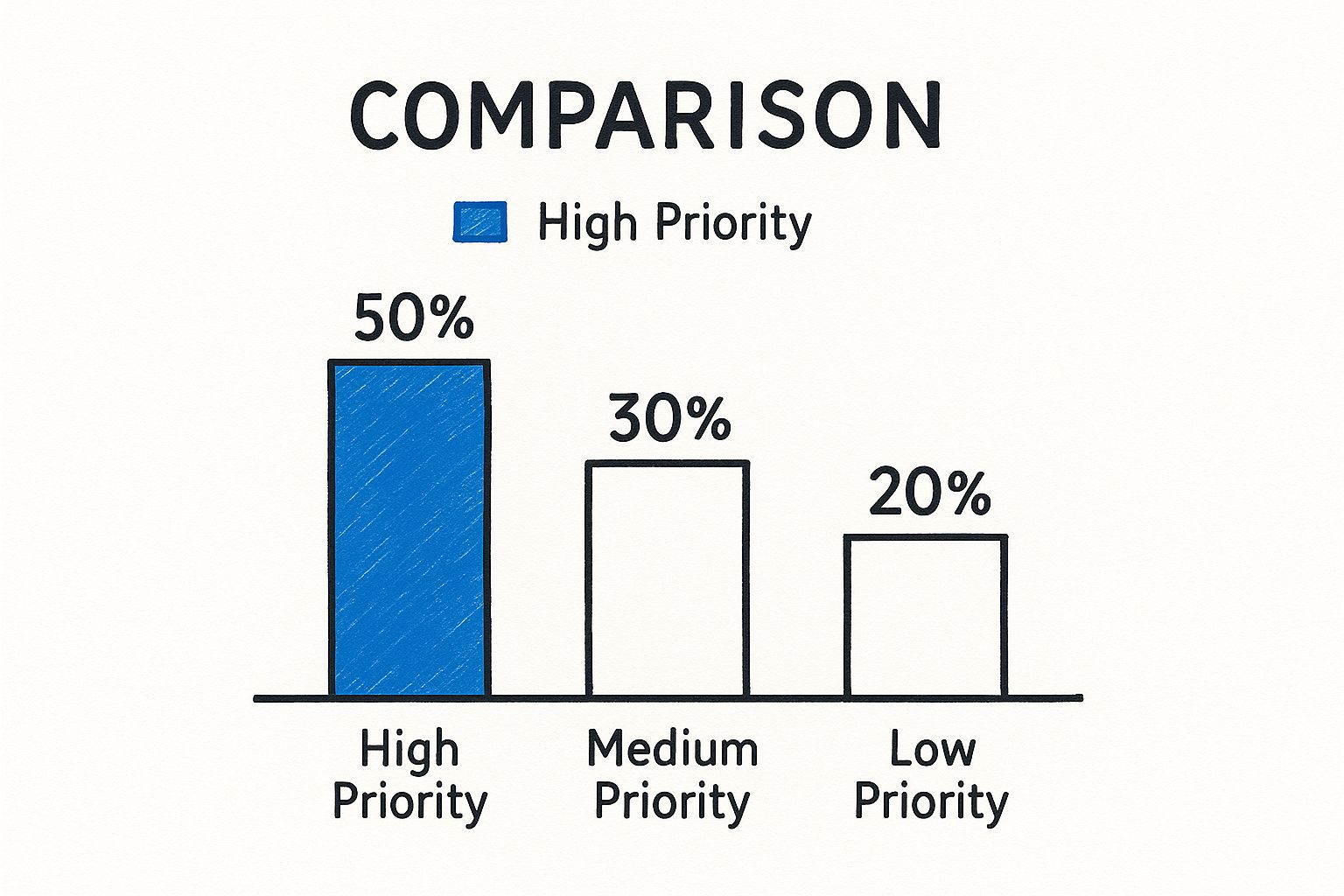
How to Assign a Task Effectively: Leadership Tips & Strategies
Learn how to assign a task effectively with our expert tips. Boost productivity and leadership skills—discover the best way to assign a task today!

Why Task Assignment Makes or Breaks Your Leadership

Effective leadership isn't about shouldering every task yourself. It's about empowering your team through strategic task assignment. Thoughtful delegation has a direct impact on team engagement, productivity, and the overall sense of trust within the group. This isn't simply about offloading work; it's a crucial element in cultivating a thriving and highly capable team. But if this is the case, why do so many leaders struggle with effective task assignment, even when they recognize its importance?
The Psychology of Delegation
Many managers inadvertently hinder their teams by retaining tasks they should delegate. This often stems from a fear of losing control or a belief in their superior speed and efficiency. However, this mindset can severely limit team growth and create a bottleneck that restricts overall productivity.
For example, consider a manager who insists on editing every piece of content the team produces. This not only slows down the content creation process but also prevents team members from honing their own writing and editing skills.
Strategic Task Assignment for Growth
Forward-thinking leaders recognize that how a task is assigned is just as critical as the task itself. They utilize task assignment as a strategic tool, not only for achieving immediate objectives but also for fostering long-term team development. This involves careful consideration of each team member's strengths, weaknesses, and career aspirations.
By assigning tasks that challenge and stretch their abilities, leaders cultivate growth and instill confidence within their teams. This approach also fosters a culture of continuous learning and improvement, which benefits both individual team members and the organization as a whole.
The Impact of Technology on Task Assignment
A significant trend in task assignment involves the increasing integration of generative AI across various organizational roles. By 2025, generative AI is projected to significantly impact time management across a wide range of tasks. Some roles, for instance, are predicted to see substantial time savings thanks to AI assistance. Find more detailed statistics here.
This integration of AI highlights the growing importance of not just how we assign tasks, but also which tasks we choose to assign. As technology continues to evolve, so too should our approach to delegation. This means leaders must adapt and learn to effectively utilize technology to optimize task assignment for maximum impact and efficiency.
The Science of How to Assign a Task That Gets Done Right

Assigning a task effectively isn't just about giving directions. It's about understanding the nuances of communication, timing, and motivation to ensure both task completion and high-quality results.
Crafting Clear and Actionable Instructions
The way you frame a task request significantly impacts its outcome. Successful managers adapt their communication style to the task's complexity. For routine tasks, clear and concise instructions are best.
For complex projects, however, providing context and explaining the bigger picture is essential. This helps team members understand the task's importance and fosters a sense of ownership.
For example, instead of simply saying "Update the website," a more effective approach would be: "Update the website's homepage banner with the new fall promotion graphics by Friday. This update is crucial for driving conversions during our upcoming campaign." This revised instruction provides both clear directions and a sense of purpose.
The Importance of Timing and Context
Timing is just as crucial as the task itself. Assigning a task at the wrong time can lead to it being overlooked or rushed. Providing context around the task's importance helps the assignee understand its significance within the broader team or project goals.
Managers should consider not just what needs to be done, but also when and why. Framing the task within the larger project context helps the assignee see the value of their contribution.
Motivating Through Ownership and Clarity
Effective task assignment encourages ownership. Engaging team members in a discussion about the task, rather than simply dictating instructions, fosters shared responsibility. This collaborative approach clarifies expectations and ensures everyone is aligned.
Visual tools can further enhance team collaboration and accountability. Using a Kanban board, such as the one available through Tooling Studio's Kanban Tasks extension, visually represents task progress. This makes it easy to track individual contributions and ensures nothing falls through the cracks.
To help illustrate best practices for assigning tasks, let's take a look at a helpful checklist.
This table provides a breakdown of essential steps, their purpose, practical examples, and common pitfalls to avoid. It serves as a comprehensive guide for managers aiming to improve their task assignment process.
| Step | Purpose | Example | Common Pitfalls |
|---|---|---|---|
| Define the Task | Clearly articulate what needs to be accomplished. | "Design three mockups for the new landing page." | Lack of specificity, unclear deliverables. |
| Explain the Why | Provide context and connect the task to broader goals. | "These mockups are needed for client presentation next week to secure project approval." | Failing to connect the task to the bigger picture. |
| Set Clear Expectations | Define deliverables, deadlines, and success criteria. | "The final designs are due by Friday at 5 PM and should adhere to brand guidelines." | Unrealistic deadlines, vague success criteria. |
| Assign Ownership | Delegate responsibility to a specific individual or team. | "Assign this task to Sarah Jones, the lead designer." | Assigning tasks without considering workload and skillset. |
| Confirm Understanding | Ensure the assignee understands the task and expectations. | "Sarah, can you summarize the task and confirm you have everything you need to get started?" | Assuming understanding without verification. |
| Provide Resources | Offer necessary tools, information, and support. | "Access the brand guidelines document on the shared drive. Reach out to John if you need assistance with the new design software." | Neglecting to provide adequate support and resources. |
| Regular Check-ins | Monitor progress and address any roadblocks. | "Schedule a brief check-in meeting on Wednesday to discuss progress and address any challenges." | Micromanaging or lack of communication. |
| Feedback and Recognition | Provide constructive feedback and acknowledge accomplishments. | "Great work on the mockups, Sarah! The client loved the innovative approach in Design #2." | Lack of feedback, neglecting to recognize good work. |
This checklist emphasizes the importance of a structured approach to task assignment. By following these steps, managers can improve clarity, boost team motivation, and ensure projects stay on track.
Confirming Understanding and Avoiding Micromanagement
Finding the right balance between clarity and micromanagement is key. Asking open-ended questions about the task can confirm understanding without being overbearing. This fosters two-way communication and allows for early clarification, preventing potential misunderstandings.
Establishing clear communication channels and regular check-in points helps maintain momentum and address any roadblocks promptly. This proactive approach keeps tasks on track while respecting the assignee's autonomy.
Matching the Right Tasks to the Right People
Effective task assignment involves more than simply handing out work. It requires a deep understanding of your team's individual skills and matching those skills to the right projects. This thoughtful approach is essential for successful delegation and fostering long-term team growth. It's about strategically utilizing each person's strengths to boost overall productivity and provide opportunities for professional development.
Building a Skill Inventory
The best managers understand the value of a comprehensive skill inventory. This goes beyond basic job descriptions. It means digging deeper to uncover each team member's hidden talents, specialized expertise, and even their career goals. This detailed knowledge allows managers to assign tasks strategically, benefiting both the project and the individual's professional growth.
For instance, imagine a team member with a background in data analysis, a skill not currently utilized in their role. Recognizing and leveraging this skill for a relevant project not only benefits the project outcome but also offers that team member a chance to apply and expand their expertise.
Balancing Workload and Opportunity
Distributing work fairly is crucial for team morale and preventing burnout. But fair distribution isn't about everyone having the exact same workload. It's about carefully balancing the challenge level of tasks with each person's capacity, offering opportunities for growth that stretch their abilities without overwhelming them. This also requires understanding individual working styles and productivity rhythms.
Furthermore, task assignment should consider the balance between urgent needs and long-term development goals. Meeting deadlines is important, but not at the cost of team growth. Finding the sweet spot between these sometimes competing priorities is a key leadership challenge. For further insights on balancing workload and boosting team productivity, check out this helpful resource: How to master Kanban tasks to boost your team productivity.
Gathering Feedback and Addressing Bias
Understanding team preferences is paramount for effective task assignment. This requires creating a psychologically safe environment where team members feel comfortable expressing their interests and concerns. Practical methods for gathering feedback include regular check-ins, anonymous surveys, and personal one-on-one conversations.
Equally important is recognizing and mitigating unconscious biases in work distribution. These biases can create unequal opportunities and hinder team development. Strategies for counteracting bias include using objective criteria for task assignments, rotating challenging assignments among team members, and actively seeking and responding to feedback about perceived unfairness.
In the ever-changing landscape of talent management, how we assign tasks is constantly evolving, particularly in hiring. Challenges like interview cancellations and rescheduling can significantly impact time-to-hire. In 2024, about 60% of organizations reported increased time-to-hire due to these issues. Find more detailed statistics here. This highlights the interconnectedness of talent acquisition and task management, emphasizing the need for adaptable strategies in both areas. By thoughtfully considering individual skills, balancing workloads, and addressing potential biases, leaders can cultivate a more productive, engaged, and ultimately, more successful team.
Technology Tools That Transform How You Assign a Task

The infographic above illustrates how tasks are distributed according to their priority. 50% are high priority, 30% are medium priority, and 20% are low. This highlights the need to prioritize effectively when assigning work. Clearly, a large number of tasks require immediate attention. Addressing high-priority tasks first ensures that the most crucial objectives are met efficiently.
Beyond simple to-do lists, task management platforms help you delegate work more effectively. These platforms offer more than just basic task assignment. They can streamline workflows, improve team collaboration, and boost overall productivity. The best tool for your team depends on your specific needs and work style. A small team might find a simple Kanban board sufficient, while a larger, distributed team might need a more robust project management platform.
Key Features To Consider When Choosing a Task Management Tool
Several important features make a task management platform truly effective:
Task Prioritization: Easily prioritizing tasks (e.g., high, medium, low) is essential for managing workflow. This ensures that the most important tasks get the attention they deserve.
Progress Tracking: Real-time progress tracking, such as visual progress bars or Kanban boards, offers insights into project status and individual contributions.
Collaboration Tools: Integrated communication tools like comments, file sharing, and @mentions facilitate seamless teamwork and keep everyone in the loop.
Automation Capabilities: Automating repetitive tasks, like assigning recurring tasks or sending reminders, saves valuable time.
Analytics and Reporting: Detailed analytics on task completion rates, individual performance, and bottlenecks help pinpoint areas for improvement.
To help illustrate the differences between some popular tools, let's take a look at the following comparison:
Task Management Tool Comparison
An evaluation of popular task assignment platforms based on key features, pricing, and best use cases
| Tool | Best For | Key Features | Limitations | Price Range |
|---|---|---|---|---|
| Trello | Small teams, visual project management | Kanban boards, collaboration tools, simple interface | Limited reporting features, can become complex for large projects | Free - $17.50/user/month |
| Asana | Teams of all sizes, project and task management | Task dependencies, timelines, project portfolios | Can be overwhelming for new users, pricing can be expensive for larger teams | Free - $30.49/user/month |
| Jira | Software development teams, Agile project management | Issue tracking, bug tracking, customizable workflows | Steep learning curve, complex for non-technical users | Free - $77.50/user/month |
| Monday.com | Marketing, sales, operations teams, customizable workflows | Visual dashboards, automations, integrations | Can be expensive, limited free plan | Free - $16/user/month |
| ClickUp | Teams of all sizes, complex project management | Nested subtasks, custom fields, time tracking | Overwhelming feature set for simple projects | Free - $19/user/month |
As you can see, each tool offers a unique set of features and pricing. Selecting the right tool depends on your team's specific needs and budget.
Tooling Studio: A Powerful Solution Within Google Workspace
For teams using Google Workspace, Tooling Studio's Kanban Tasks extension seamlessly integrates a visual Kanban board directly into Gmail and Google Tasks. This eliminates app switching and centralizes task management.
Key advantages of Kanban Tasks:
Native Google Integration: Works within Gmail and Google Tasks, streamlining workflows.
Visual Task Management: The Kanban board provides a clear overview of task status and progress.
Intuitive Drag-and-Drop Functionality: Easily move tasks between stages, assign owners, and change priorities.
Real-time Collaboration: Facilitates team communication and ensures everyone stays informed.
This integration provides a more efficient approach to task assignment, fostering better collaboration and productivity. Tooling Studio's forthcoming Sales CRM extension will further enhance workflow management within Google Workspace. Choosing the right technology can greatly impact a team's ability to delegate effectively. By considering these features and exploring tools like Tooling Studio, you can transform task assignment and unlock your team’s potential.
Capacity Planning: The Foundation of Effective Assignment

Even the most carefully planned task assignments can fail if your team is overloaded. Understanding your team's capacity before assigning tasks is essential. This goes beyond simply knowing job titles. It requires a deep understanding of their current workload, available time, and individual work styles. This section explores how to accurately assess and plan for your team's capacity to ensure effective task assignment.
Measuring Team Capacity Accurately
Effective capacity planning starts with accurate workload measurement. This means using systems that capture both the visible work, such as project tasks and meetings, and the invisible work. Invisible work includes tasks like email management, administrative duties, and even the mental effort of switching between different projects. Failing to account for these invisible tasks can lead to underestimating the true workload and increase the risk of burnout.
For example, a team member might appear to have a light workload based on their assigned project tasks. However, they could be struggling with a large volume of emails or support requests, significantly impacting their productivity. Accurate capacity planning demands tools and processes that account for all demands on the team's time.
Forecasting Demands and Identifying Bottlenecks
Successfully assigning tasks also relies on anticipating future needs. This means understanding not only your team's current capacity, but also forecasting future project demands. This involves carefully reviewing project timelines, dependencies between tasks, and potential obstacles. Skilled managers can identify potential bottlenecks weeks in advance.
This foresight allows them to adjust task assignments, redistribute resources, or bring in extra help as needed. This proactive approach prevents last-minute problems and keeps projects on track. For practical strategies on improving workflow and managing capacity, you might find this helpful: How to master efficient task management in Google Workspace.
Balancing Workloads and Prioritizing Tasks
Effective capacity planning recognizes that individuals work differently. It means accounting for different productivity patterns, working styles, and recovery needs across the team. Some team members excel under pressure, while others require more focused time for deep, concentrated work. Understanding these nuances is essential for assigning tasks effectively and minimizing stress.
Furthermore, capacity planning helps businesses ensure adequate resourcing. By 2025, businesses are predicted to prioritize strategic capacity planning for resilience and adaptability, using data analysis and predictive modeling to anticipate future requirements. This ensures efficient task management and delegation without overwhelming teams. Explore this topic further. Understanding these factors facilitates data-driven decisions about task assignments, helping determine whether to assign internally, outsource, postpone, or even eliminate tasks entirely. By considering these elements, managers can distribute work strategically, create a balanced work environment, and maximize team performance.
The Follow-Through: Turning Task Assignment Into Results
Assigning a task is just the first step. The real key to success lies in what happens after the assignment. This involves monitoring progress, offering support, and learning from the entire process. It's not about micromanaging, but about effective leadership that empowers teams to deliver results.
Monitoring Progress Without Micromanaging
Effective follow-through requires a delicate balance: providing support while allowing team members autonomy. Instead of constant oversight, establish clear communication channels and regular check-in rhythms. These check-ins offer opportunities to address roadblocks, provide guidance, and ensure the task remains aligned with overall goals. The frequency should depend on the task's complexity. A simple task might only need a quick check-in near the deadline, while a complex project benefits from regular, shorter meetings.
Visual progress tracking tools, such as Tooling Studio's Kanban Tasks extension, offer transparency without requiring constant updates. This allows team members to concentrate on their work while keeping everyone informed on the overall project status.
Creating Psychological Safety for Early Issue Detection
Strong leaders cultivate an environment of psychological safety. This means team members feel comfortable raising potential problems early, rather than hiding them until they become major obstacles. This open communication is crucial for addressing challenges proactively and preventing small setbacks from derailing the entire project.
For example, a team member struggling with a task aspect should feel safe raising their concerns without fear of judgment. This enables the team to brainstorm solutions and adjust their course as needed.
Constructive Intervention and Performance Management
Sometimes, tasks veer off track, requiring intervention. This calls for a constructive approach that addresses the issue without impacting the team member's motivation. Framing feedback as a learning opportunity, not criticism, is essential.
Provide specific, actionable suggestions for improvement. Focus on how the individual can develop their skills for future tasks. Tools like conversation templates can structure these discussions, ensuring they remain productive and focused on improvement.
Debriefing and Continuous Improvement
Forward-thinking managers see task completion as a learning opportunity. Implementing structured debriefs after a task is finished allows for reflection on what worked well, what could be improved, and how to optimize processes for future projects. This continuous improvement cycle is essential for individual and team growth.
This process could involve gathering feedback, analyzing performance data, and identifying areas where new tools or training could be beneficial. By consistently reflecting on each task's outcome, teams can continuously refine their performance and achieve better results over time.
Avoiding the Task Assignment Traps That Derail Teams
Assigning tasks effectively is crucial for team success. However, even the most seasoned managers can fall prey to common pitfalls. These mistakes can range from unclear directions to mismatched skills, ultimately derailing projects and negatively affecting team morale. This section explores these common traps and offers practical strategies to avoid them.
The Clarity Trap: When Instructions Get Lost in Translation
One of the most common task assignment traps is a lack of clarity. This happens when instructions are vague, incomplete, or open to misinterpretation. Imagine giving someone directions to a restaurant without a specific address – they might end up somewhere completely different!
Symptom: Team members repeatedly ask clarifying questions, deliver work that misses the mark, or express confusion about their responsibilities.
Solution: Provide clear, concise instructions, including the task's purpose, the desired outcome, and specific deadlines. Confirm understanding by asking the assignee to summarize the task back to you.
The Skill Mismatch Trap: The Wrong Person for the Job
Another frequent trap is assigning tasks to people who lack the necessary skills or experience. This can result in frustration, delays, and subpar results. It's like asking a plumber to rewire your house – they might try, but it's not their expertise.
Symptom: The assignee struggles to complete the task, asks for excessive help, or produces low-quality work.
Solution: Before assigning a task, evaluate each team member's skills and experience. Consider maintaining a skill inventory to quickly identify the best person for each job. If there's a skill gap, provide training or assign the task to someone more qualified.
The Motivation Trap: When Enthusiasm Fades
Even with crystal-clear instructions and the right skills, a lack of motivation can derail a task. This can stem from feeling overwhelmed, undervalued, or disconnected from the task's purpose. It's like asking someone to run a marathon without explaining why – they might start strong, but their motivation could quickly disappear.
Symptom: The assignee procrastinates, misses deadlines, or demonstrates little enthusiasm for the task.
Solution: Clearly explain the task's importance and how it contributes to the overall project or team goals. Offer regular encouragement and acknowledge their efforts. Provide autonomy and empower them to take ownership of their work.
The Resource Constraint Trap: Too Much Work, Not Enough Time
Finally, teams often encounter resource constraints, such as limited time, budget, or tools. Assigning tasks without considering these limitations sets the team up for failure. It's like asking someone to bake a cake without an oven – they simply can't.
Symptom: The assignee expresses frustration about unrealistic deadlines or a lack of necessary resources. Projects fall behind schedule.
Solution: Before assigning tasks, carefully evaluate available resources and project timelines. Prioritize tasks strategically and eliminate non-essential work. Be realistic about deadlines and adjust them if necessary. If resources are truly limited, consider outsourcing or delaying certain tasks. You might be interested in: Top 7 Task Management Mistakes And How To Avoid Them.
By understanding and addressing these common task assignment traps, you can boost team efficiency, minimize frustration, and increase the likelihood of project success. These proactive steps contribute to a more positive and productive work environment.
Ready to improve your task assignments and boost team collaboration? Explore Tooling Studio's powerful Google Workspace integrations and experience a more efficient workflow today.